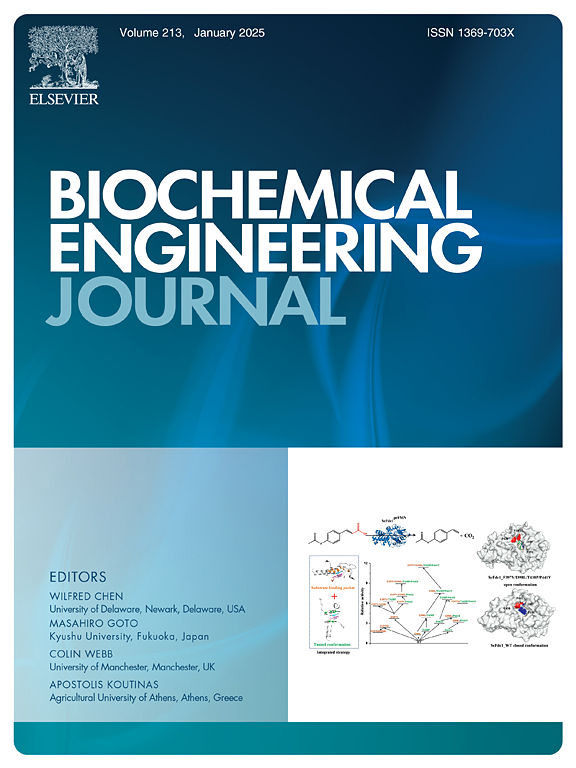Insights into magnetic biofilm carriers driving stable partial nitrification by selectively enriching ammonia-oxidizing bacteria
IF 3.7
3区 生物学
Q2 BIOTECHNOLOGY & APPLIED MICROBIOLOGY
引用次数: 0
Abstract
Biofilm carriers can effectively support the retention of functional microorganisms augmenting the partial nitrification (PN) process. However, conventional biofilm carriers are ineffective in selectively enriching key ammonia-oxidizing bacteria (AOB) hindering the sustained nitrite (NO2--N) accumulation. This study introduces magnetic modified polyurethane (MF) carrier facilitates the selective enrichment of AOB and suppression of NO2--N oxidizing bacteria. The results demonstrate that the MF system achieves over 90 % NO2--N accumulation. The magnetic field fosters continuous biomass accumulation, while the regulated secretion of extracellular polymeric substances ensures the stability of AOB under fluctuating conditions. Microbial community analysis revealed that MF significantly enhanced biofilm formation potential and the resilience of system. Furthermore, compared to the control, the relative abundance of Nitrosomonas increased by 10 % in MF. These findings suggest that magnetic carriers represent an efficient strategy for enhancing AOB and offering a robust approach for the rapid initiation the PN process.
磁性生物膜载体通过选择性富集氨氧化细菌驱动稳定的部分硝化
生物膜载体可以有效地支持功能微生物的保留,增强部分硝化过程。然而,传统的生物膜载体在选择性富集关键氨氧化细菌(AOB)方面效果不佳,阻碍了亚硝酸盐(NO2——N)的持续积累。本研究引入磁性改性聚氨酯(MF)载体,有利于AOB的选择性富集和NO2—N氧化菌的抑制。结果表明,MF体系的NO2—N累积量达到 %以上。磁场促进了生物量的持续积累,而胞外聚合物质的调控分泌保证了AOB在波动条件下的稳定性。微生物群落分析表明,MF显著提高了系统的生物膜形成潜力和恢复力。此外,与对照相比,亚硝化单胞菌在MF中的相对丰度增加了10 %。这些发现表明,磁性载体是一种有效的增强AOB的策略,并为快速启动PN过程提供了一种可靠的方法。
本文章由计算机程序翻译,如有差异,请以英文原文为准。
求助全文
约1分钟内获得全文
求助全文
来源期刊

Biochemical Engineering Journal
工程技术-工程:化工
CiteScore
7.10
自引率
5.10%
发文量
380
审稿时长
34 days
期刊介绍:
The Biochemical Engineering Journal aims to promote progress in the crucial chemical engineering aspects of the development of biological processes associated with everything from raw materials preparation to product recovery relevant to industries as diverse as medical/healthcare, industrial biotechnology, and environmental biotechnology.
The Journal welcomes full length original research papers, short communications, and review papers* in the following research fields:
Biocatalysis (enzyme or microbial) and biotransformations, including immobilized biocatalyst preparation and kinetics
Biosensors and Biodevices including biofabrication and novel fuel cell development
Bioseparations including scale-up and protein refolding/renaturation
Environmental Bioengineering including bioconversion, bioremediation, and microbial fuel cells
Bioreactor Systems including characterization, optimization and scale-up
Bioresources and Biorefinery Engineering including biomass conversion, biofuels, bioenergy, and optimization
Industrial Biotechnology including specialty chemicals, platform chemicals and neutraceuticals
Biomaterials and Tissue Engineering including bioartificial organs, cell encapsulation, and controlled release
Cell Culture Engineering (plant, animal or insect cells) including viral vectors, monoclonal antibodies, recombinant proteins, vaccines, and secondary metabolites
Cell Therapies and Stem Cells including pluripotent, mesenchymal and hematopoietic stem cells; immunotherapies; tissue-specific differentiation; and cryopreservation
Metabolic Engineering, Systems and Synthetic Biology including OMICS, bioinformatics, in silico biology, and metabolic flux analysis
Protein Engineering including enzyme engineering and directed evolution.
 求助内容:
求助内容: 应助结果提醒方式:
应助结果提醒方式:


